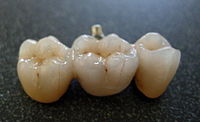
Photo from wikipedia
OBJECTIVE The purpose of this laboratory study was to evaluate the fatigue resistance, fracture resistance and mode of failure of posterior hybrid-abutment-crown vs. hybrid-abutment with separate crown, both bonded to… Click to show full abstract
OBJECTIVE The purpose of this laboratory study was to evaluate the fatigue resistance, fracture resistance and mode of failure of posterior hybrid-abutment-crown vs. hybrid-abutment with separate crown, both bonded to short titanium bases. MATERIALS AND METHODS Thirty-two titanium implants were embedded perpendicularly in auto-polymerizing resin. Implant-supported restorations simulating a maxillary first premolar were designed and milled using a CAD/CAM system and divided into 2 groups according to material (n = 16): zirconia (Z) and lithium disilicate (L). Each group was subdivided into two subgroups according to design (n = 8): hybrid-abutment-crown (ZS, LS) and hybrid-abutment with separate crown (ZC, LC). Each group was subjected to 1.2 million cycles of thermo-mechanical fatigue loading in a dual-axis chewing simulator at 120 N load. Surviving specimens were subjected to quasi-static loading in a universal testing machine. Mode of failure was determined under a low magnification optical microscope. RESULTS During chewing simulation, 18.8% of zirconia and 43.8% of lithium disilicate restorations failed. The fracture resistance median values ranged from 3,730 N for group ZC, 3,400 N for group ZS, 1,295 N for group LS to 849 N for group LC. Group ZC had a statistically significant higher fracture resistance than groups LC and LS; however, it did not differ significantly from group ZS (p ≤ 0.05). Failures were seen in both titanium bases and ceramic superstructure. CONCLUSIONS Zirconia and lithium disilicate hybrid implant-supported restorations with short (3 mm) titanium bases failed in a considerable number already during chewing simulation. Therefore, despite their high fracture strength the use in the posterior region should be considered critically.
Journal Title: Clinical Oral Implants Research
Year Published: 2019
Link to full text (if available)
Share on Social Media: Sign Up to like & get
recommendations!